|
Comparative testing of Double-Bell heat-exchange system and Ortner KMS channel-style heat exchange system at Ortner GmbH, Austria, May 2014.
Report by:
Alex Chernov
President
Stovemaster Ltd
First of all, I would like to express my gratitude to Ortner GmbH for supporting the testing idea and making it happen by providing facilities, equipment and all necessary materials for the experiment as well as making Ortner employees available for help whenever we needed it. I greatly appreciate supreme hospitality and generous arrangements for our stay and work. This experiment would not have happened without full support of your company. Thank you!
I also would like to give special thanks to Paul and Stefan Polatschek for being instrumental in organizing the event and for generous investment of your personal time. Thank you!
The idea of this experiment surfaced and shaped up during our conversations with Stefan and Paul Polatschek about what could be a nice idea for a workshop that involves use of modular elements, produced by Ortner, and some creative hand-building. We decided that it would be very interesting to compare performance of two different heat-exchange systems, using the same modular firebox, produced by Ortner. Thus goals for the experiment were set:
- We would start with the same modular firebox, produced by Ortner, and build two-versions of heaters: a hand-built Double-Bell, using standard schamotte bricks and tiles, and a channel-type traditional heater, using modular Ortner KMS channel system.
- We would cure heaters and run two full tests on both versions to compare efficiency and emissions numbers.
The idea came into realization in May 2014, following a generous offer from Ortner GmbH to conduct this experiment, using their newly-built teaching facility.
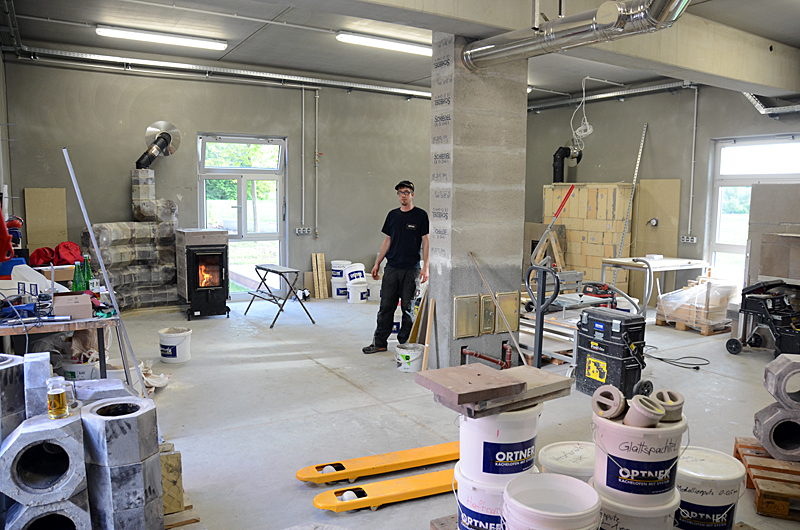
Ortner’s new training facility. You can see both versions of the tested heaters at the back: KMS on the left and double-bell on the right. The facility has garage doors for easy forklift access and eight chimneys at different locations.
Construction of the heaters
Ortner GO-11 firebox (11kg load) was selected as the starting point.
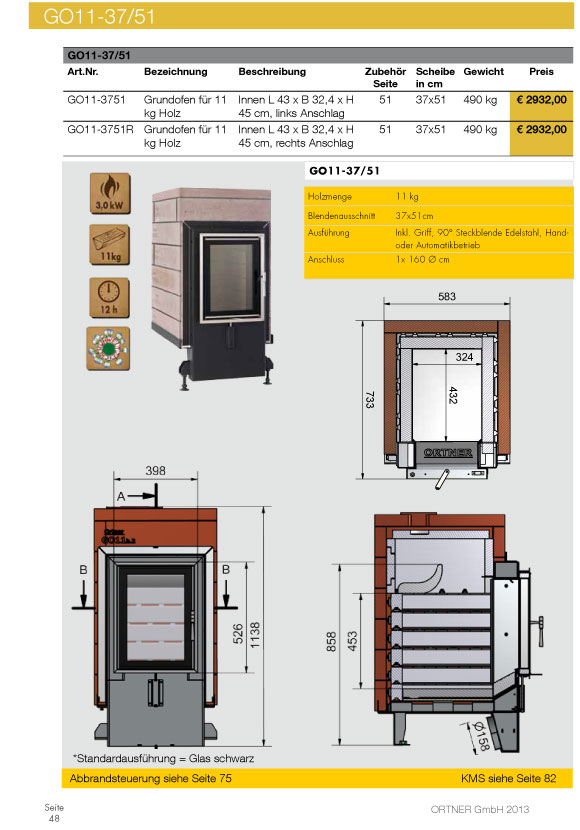
We built a simple double-bell version of the heater first. The heater is similar to the shape we built at the Wild Acres workshop in 2008 http://mha-net.org/docs/v8n2/wildac08f.htm We calculated weight and volume of the double-bell heat exchange portion of the double-bell heater to match it with the KMS system.
BELL heater_3D.pdf
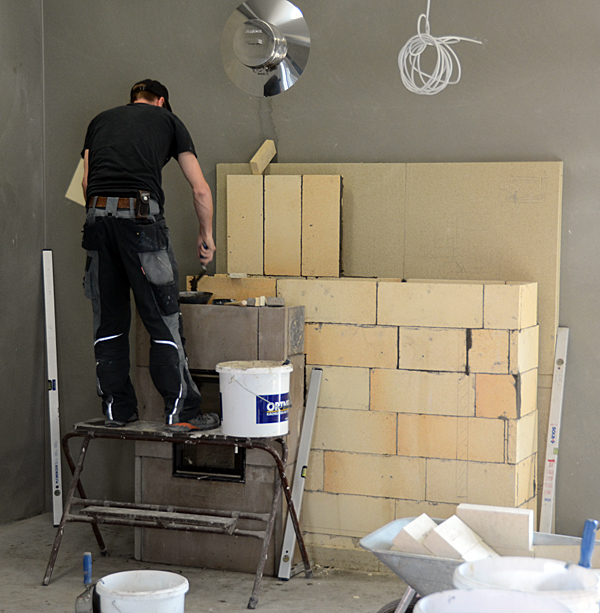
Paul working on the double-bell heater. Note that firebox has facing. No facing on the heat-exchange portion.
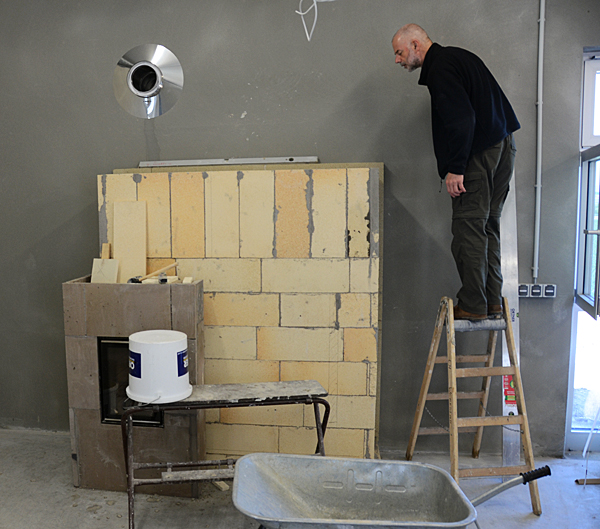
Stefan calculates weight and volume of the double-bell heat exchanger.
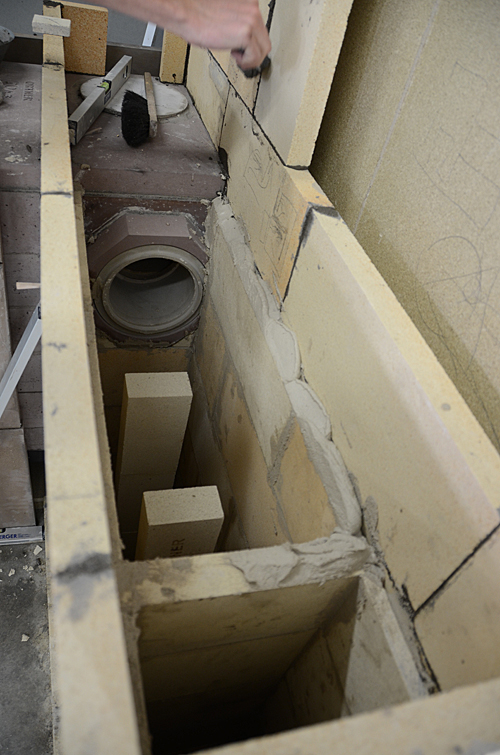
Lower bell. Firebox connection and dry-stacked columns inside the bell are visible.
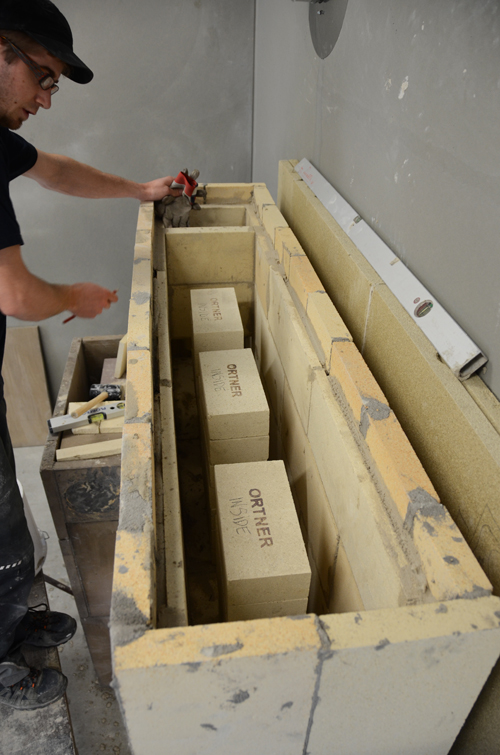
Upper bell. Dry-stacked columns inside. Updraft into the chimney connection at the back.
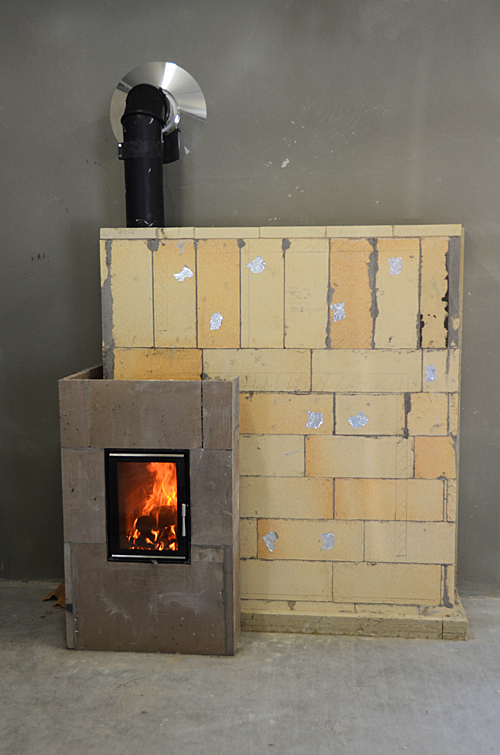
Finished double-bell heater version during curing fire. Gases exit firebox on the top right. A drawing on top of the tiles, done in pencil, shows approximate layout of the bells.
The bells were built in double-wall principle without air space: 40mm tile outside, laid with Ortner Haftmortel – a fast-setting super-strong gas-tight mortar, and 20mm tile inside with 10mm of solid clay mortar in-between inner and outer tile. This is an exact way how one would build a heater core to be faced with air space between the shell (the third, and final layer) and the core.
KMS version followed. We created this version to reach roughly the same mass and volume.
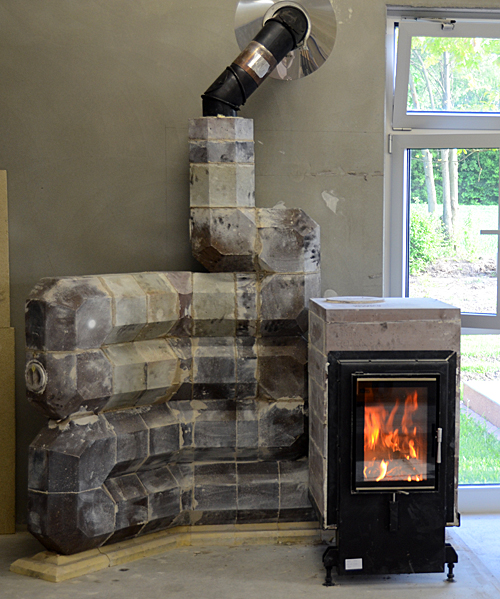
Finished KMS version with curing fire. Gases exit the firebox on the back into a short downdraft channel (sturzzug) before turning left along the floor. The “sturzzug” cannot be seen on this picture.
It should be noted that both versions were connected to chimneys of the same size and height. The chimneys were short – only about 15ft, counting from the floor level. This fact together with very warm weather outside (+26C) made conditions not very favorable for the heaters, but conditions being equal for both versions, were accepted as something that should not affect our ability to compare performance.
It was noted that resulting length of the channels in the KMS version was way longer than any traditional Austrian calculation method would allow. We were told that this version would not pass Austrian Kachelofenverband’s calculator’s rules. We run the resulting channel length and shape through Ortner’s proprietary calculation software and received a conclusion that resulting temperature of gases in the chimney at the end of the channel would be 3 degrees Centigrade in such configuration… While obviously unrealistic result, it indeed indicated that this channel system was much longer anyone would safely build in the field.
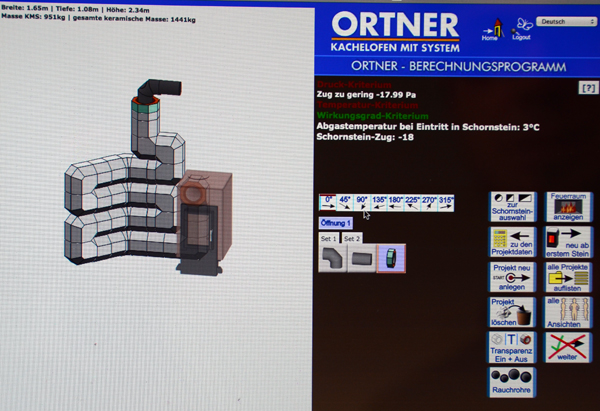
Screen shot from the Ortner’s calculation program.
Both versions were completed and cured with one full load one day ahead of testing.
Testing
Efficiency and CO emissions data was collected using gas analyzer and Stack Loss method. PM data was collected by Condar Dilution Tunnel. Otner provided NOVA H8 MRU gas analyzer used in their development lab, and MHA Lopez Labs testing co-op has provided Condar Dilution Tunnel to measure Particulate Matter. It was discovered that NOVA H8 did not have CO dilution mode for measurements above 4000ppm CO. We also had a Testo 330-2 gaz analyzer, provided by Luis Wegscheider, but since there was no computer available with Easy Heat Testo software for automatic recording of readings from Testo 330-2, we decided on using the NOVA to have automated recording of the test data into Excel spread sheets.
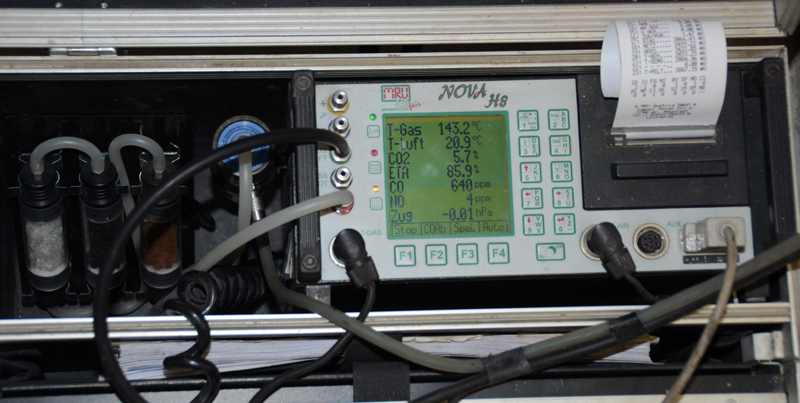
NOVA H8 MRU in test.
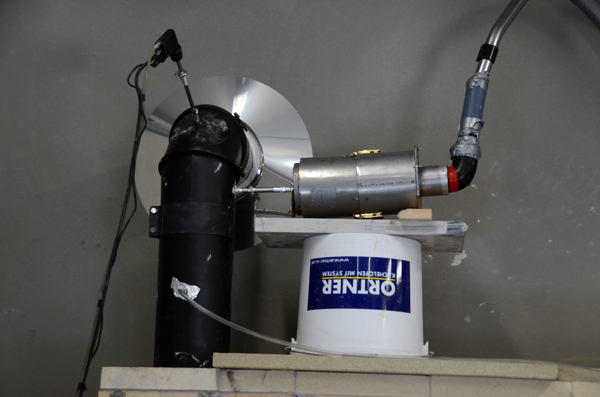
Testing set-up for the double-bell heater version. Probe from the NOVA on the left, Condar on right.
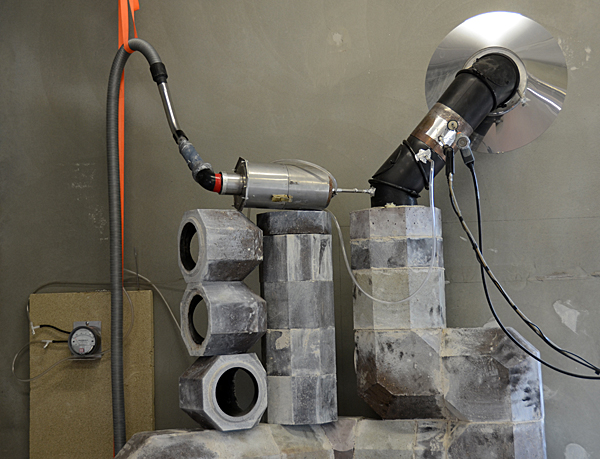
KMS version testing set-up. Probes from NOVA and TESTO on the right, Condar with Magnehelic on the left.
The double-bell heater was also equipped with 9 temperature sensors, inserted into the bells at various locations to collect data, which could possibly show pattern of gas movement inside the bells. The sensors fed into a Testo reader, which logged the data automatically into Excel spreadsheets.
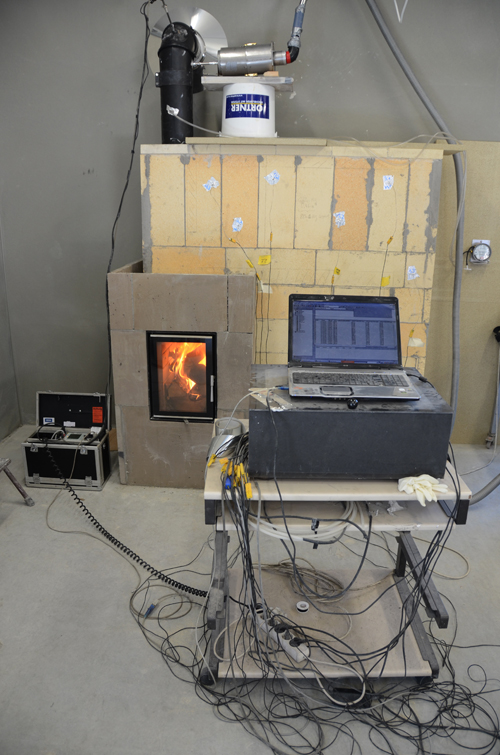
Bell heater testing set-up during test. Note temperature sensors on the body with aluminum tape, taping the holes.
Testing was conducted according to European standard with end of the test, calculated at reaching 25% of the highest CO2 measurement, reached during the test. It should be noted that this end of test point typically happens much earlier than 95% O2 recovery point as is standard in North American standards.
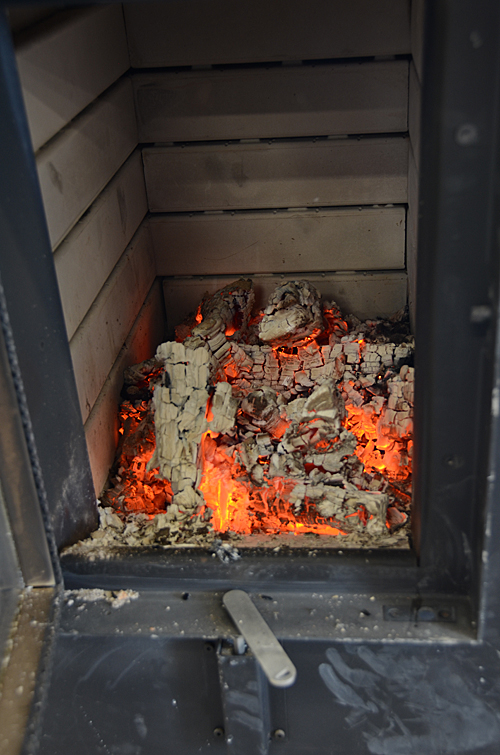
This picture is taken at the end of the test, when 25% of CO2 is reached. Typically, tests ended up to be around 2hrs long. Air supply would be shut off at this time and leftover charcoal would sit in the heater for another couple of hours before mostly burning off or getting self-extinguished.
Each load was weighed exactly to 11kg with 0.7lg of loose kindling. All test were done using the same loads or roughly the same size of wood from the same pile. An interesting observation was that wood moisture content was not normally measured in Ortner’s lab, assuming firewood they receive “I should be dry”. Therefore, no Delmhorst or comparable professional-grade moisture meter was available on site to measure moisture content. Therefore, 15% moisture content number used in Condar spreadsheet s is hypothetical. It should be noted that the pile of wood we used for tests indeed looked and behaved dry…
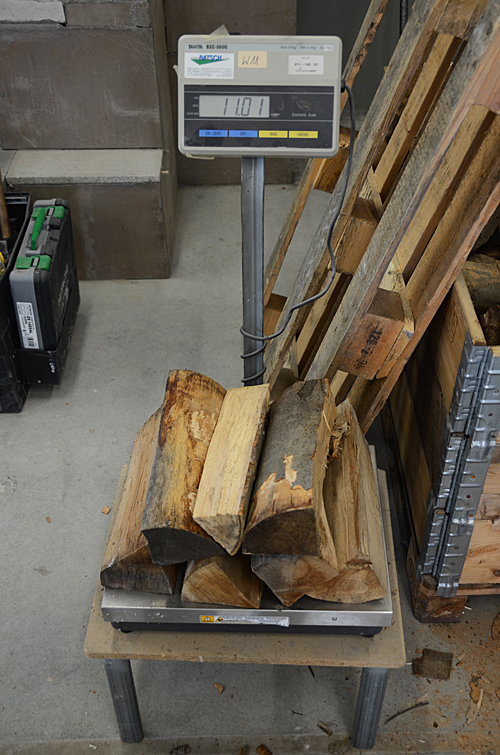
Normal load.
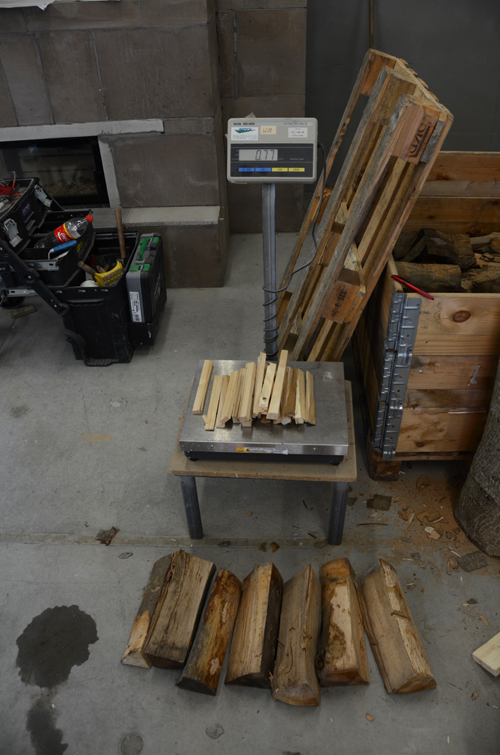
Kindling.
Wood species: Beech. Size was average based on North American standards.
Heaters were fired with a single load of 11kg with 0.7kg of loose kindling, placed on top. Fire started with two fire-starting sticks made from compressed fiber and wax.
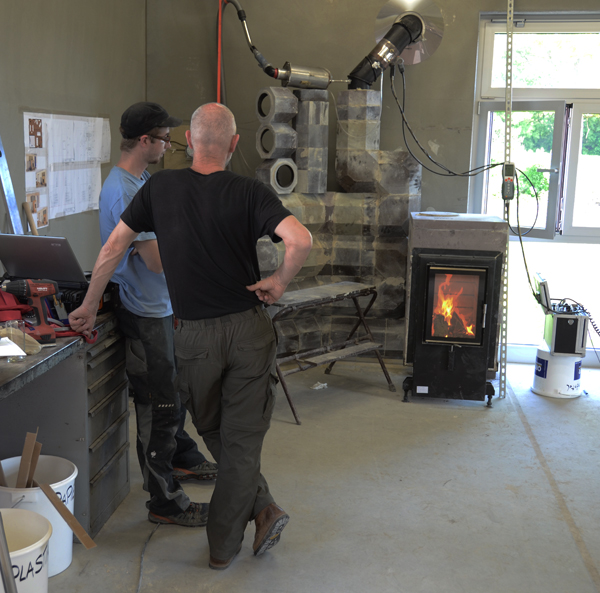
Testing Observations and Notes
Due to short chimneys and very warm weather outside, both heaters were sluggish on start during the first test firing. Both required priming of the chimney with a paper torch through the chimney base clean-out at the beginning of the first test to establish sufficient draft. It should be noted that both have improved for the second firing, having warmer core, and none required priming of the chimney. However, the improvement of behaviour on the start was much more pronounced on the bell heater, which, being freshly built, had a lot of residual moisture from mortar at the beginning of the first test run, while KMS system is virtually-dry-fitting and as such had no retained moisture at the start of the first test. With moisture largely evaporated from the double-bell heater, its second test run was much smoother, starting without difficulty.
Due to very weak chimney draft at the beginning of the first tests, both heaters had CO spikes above 4000ppm in the first quarter of the test runs. Not having CO dilution option, NOVA analyzer would shut CO measuring cell down for purging every time it hit 4000ppm and would lose several minutes before restarting CO measurements. This certainly had effect on the CO averages reported. The averages must be higher than reported, especially for the first test runs and for the KMS version, since it visually continued struggling from weak draft even during beginning of the second test run. Since data was affected for both heater runs and since we had no correct CO readings, the comparison was made, using the data as reported.
The KMS version was observed to struggle without sufficient draft for the major portion of the burn, which was reflected in the emission test results. The double-bell version was burning quite smoothly with exception of the start of the first test run. It was interesting to observe that, while fire was burning visually better in the bell than in the KMS version, the double-bell version had very low chimney pressure at the base of the chimney. So low, that at first it was suggested that NOVA was giving improper pressure measurements. We checked this by measuring pressure with Testo 330-2 and found that this was true – pressure was low and stayed low during entire burn. In contrast, draft pressure was much higher even at the beginning of the test in the KMS version, and increased substantially towards end of the test, while fire was visually struggling from weak draft during most of the test.
Each heater version had two full test runs, each run 22 to 24 hrs from the previous fire (the first run 24hrs after the curing fire).
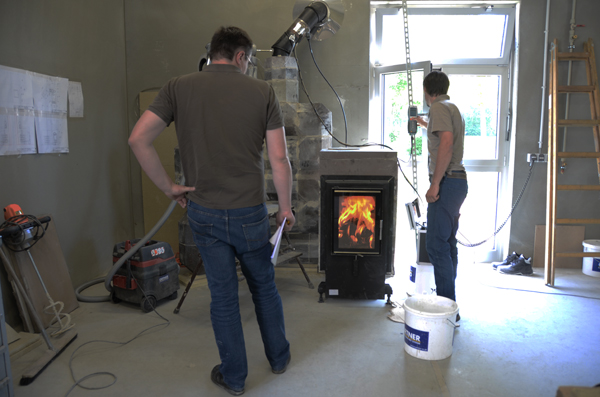
Test results
Efficiency and Emissions Results.
Test results were entered into Condar reporting spreadsheets. They are available here: (Condar_bell_01_May21.xls; Condar_bell_02_May22.xls; Condar_KMS_ 01_May21.xls; Condar_KMS_02_May22.xls). Summary is below:
Summary of test results Double-Bell heater vs Ortner KMS
Both with Ortner GO-11 firebox, fired with the same fuel under the same conditions
Test ID |
PM g/kg |
CO g/kg |
Stack T(F) |
O2 % |
CO ppm |
Eff. Condar % |
Eff. MRU % |
BO-001 |
0.58 |
15.10 |
197 |
12.3 |
1048 |
82 |
89 |
BO-002 |
0.27 |
14.38 |
232 |
12.8 |
940 |
80 |
91 |
|
|
|
|
|
|
|
|
KMS_001 |
1.18 |
16.99 |
176 |
13.0 |
1083 |
82 |
91 |
KMS_002 |
0.80 |
15.11 |
181 |
12.2 |
1061 |
83 |
93 |
* both versions required priming of the chimney at the beginning of the first run
BO – double bell version; KMS – KMS version
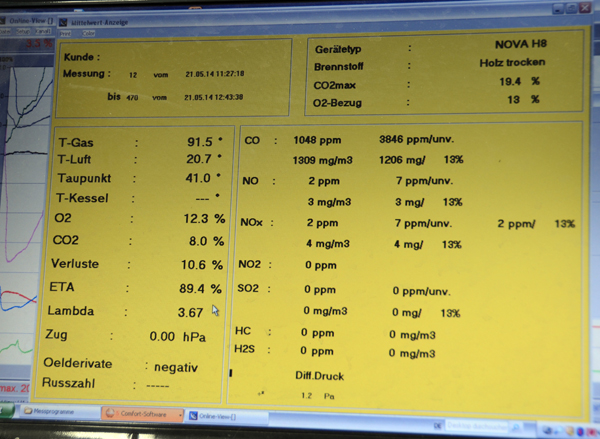
Screen shot of averages from BO-001 test run.
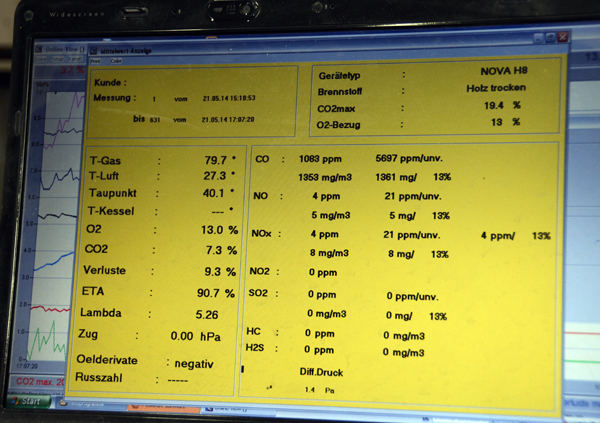
Screen shot of averages from KMS_001 test run.
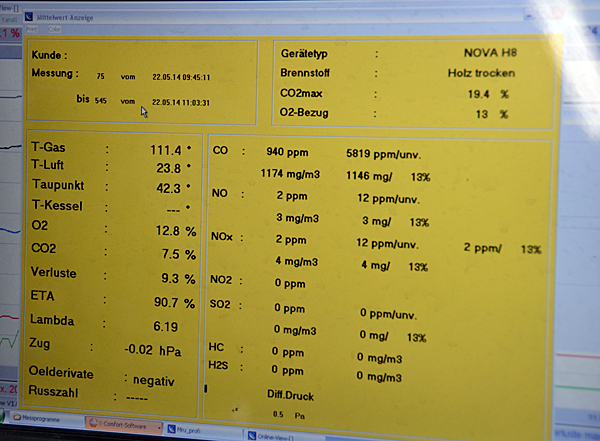
Screen shot of averages from OB-002 test run.
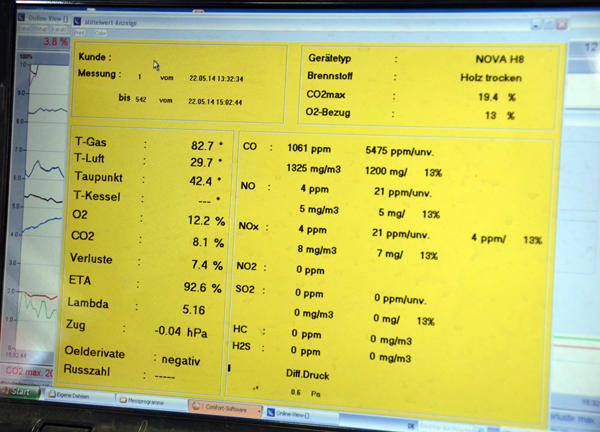
Screen shot of averages from KMS_002 test run.
It is evident from the results as well as from observation that KMS version was indeed struggling from insufficient draft, caused by high resistance to the gas flow in the particular channel configuration. Although we cannot see the difference in CO numbers (which may be the result of measurements being affected by the inability to measure high CO numbers), PM measurements are more than twice higher for the KMS version in comparison to the double-bell version. There is also much less improvement from the first to the second run, where PM emissions in the double-bell version dropped about 50% , while only about 30% in KMS.
The double-bell heater version had second firing on the second test day after finish of the second official test run. Louis Wegscheider arrived this day, having missed all the testing due to work commitments. He was intrigued by the data we collected and wanted to witness one complete run by himself, so we did one more firing, which was measured and recorded with the NOVA only. The test run, done about 6hrs after previous fire, was very smooth and clean, resulting in average numbers of 252F stack temperature, 13% O2 and 554ppm CO, while still maintaining 85% efficiency as measured by NOVA analyzer.
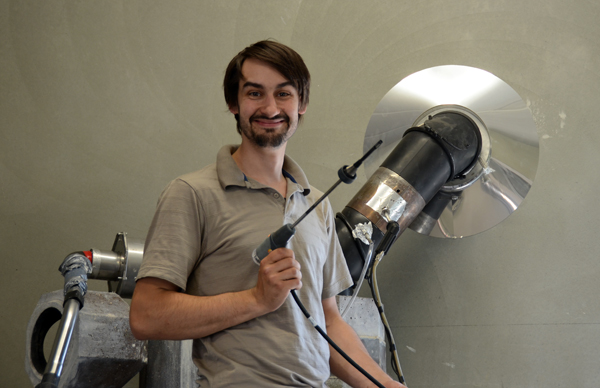
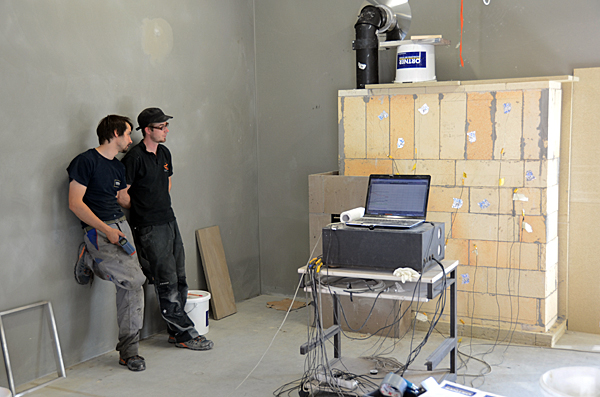
Temperature Distribution in the Double-Bell Version
Temperatures in the bells were measured and recorded for three straight days 24/7. The data was then cut into test runs and placed into graphs by Thomas Maurer, Ortner’s lab employee.
Here is the picture with marked sensors:
20140521_Messaufbau_Double_Bell_heater.pdf
Below are graphs that show temperature difference between sensors, inserted in the top and bottom of the bells. First, there are two graphs, which show difference during two test runs:
20140521_1_Abbrand.pdf;
20140522_1_Abbrand.pdf
Here is the graph, that shows temperatures from three firings during two days:
20140521_Temperaturverlauf_gesamt.pdf
It is evident from looking at the graphs that there is temperature difference between bottom and top of the lower bell of about 50 degrees at the beginning of the burn, which rises to 100C during middle of the test. The difference is more significant between lower and upper bell. It is also clear that temperature difference between top and bottom of the bells and between bells decreases and almost levels off with time.
The graphs confirm with clarity that the double bell heater had gas movement pattern exactly as was predicted in theory: with hotter gases rising towards top of the bell and with lower bell receiving majority of the heat. It also confirms another theoretical and empirical observation that with time temperatures inside the bells level off, creating very evenly heated mass.
Conclusion
As we observed in the testing, the channeled system was unable to maintain the same level of efficiency and emissions as the double-bell system under the same conditions. This means that creation of a channeled system of the same mass and volume as a more-or less standard-size bell heater can be a challenge, as it was shown that such system may create too much resistance to the gas flow. Although Paul Polatschek has stated that such large systems were built in the past and they can operate properly, he mentioned necessity for such systems to either have higher chimneys or to have reduced number of elbows to reduce resistance. It should be noted that the first would change conditions from what we have tested and the second would most likely result in necessity to utilize larger volume to be occupied by the channel system, so the result would not match the original requirements.
Based on test results and observations in the comparative testing, it can be concluded that double-bell heat-exchange system offers better possibilities than a channeled system. It is clear that in most cases a channeled system would have to be smaller under the same conditions in order to operate properly. Therefore, double bell heater would routinely offer considerably greater efficiency than a channeled system of the same volume and mass. It can also be concluded that double-bell system would be a better choice for less than ideal conditions due to very low resistance to the gas flow and ability to operate properly with low emissions under minimum draft.
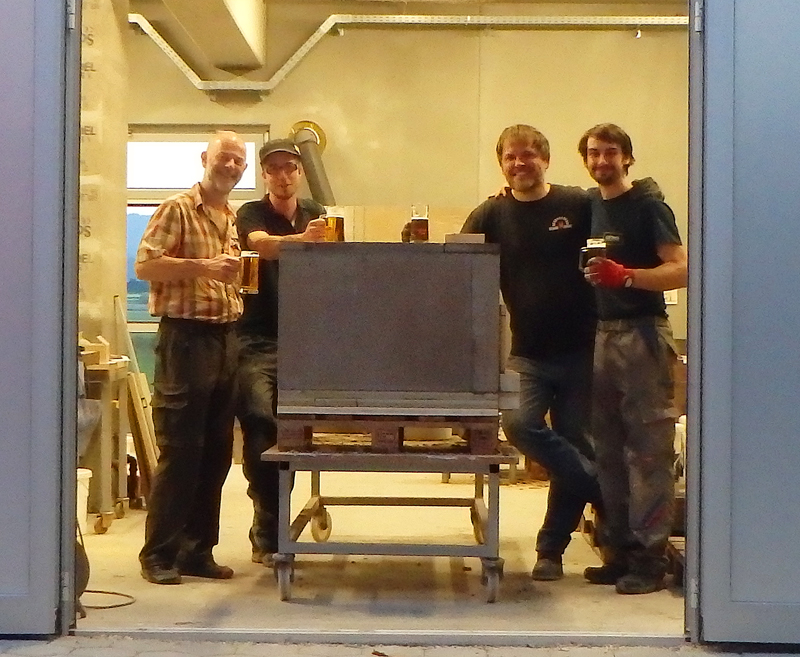
|